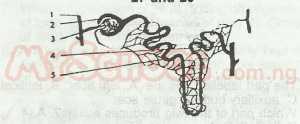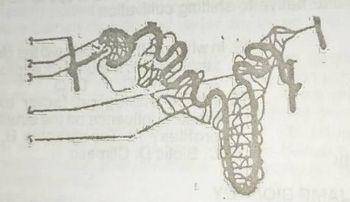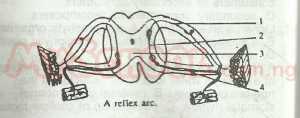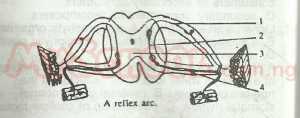Year :
1990
Title :
Biology
Exam :
JAMB Exam
Paper 1 | Objectives
41 - 50 of 50 Questions
| # | Question | Ans |
|---|---|---|
| 41. |
Which set of disease is spread mainly by insect vectors? A. Cholera, tenia and gonorrhoea B. Poliomyelitis, tuberculosis and syphilis C. Cholera, malaria and tuberculosis D. Malaria, cholera and river blindness |
D |
| 42. |
Which of the following constitute pollution? A. Droppings from birds B. loud disco sound C. A pack of cigarettes D. Refuse in an incinerator |
B |
| 43. |
An acidic soil can be improved upon by A. sedimentation B. leaching C. flocculation D. watering |
C |
| 44. |
What do bacteria in root nodules derive from the host plant? A. Protection and minerals B. Water and minerals C. Carbonhydrates and water D. Protection and carbohydrates |
A |
| 45. |
Free nitrogen is released to the atmosphere by A. Nitrogen-fixing bacteria B. nitrifying bacteria C. denitrifying bacteria D. saprophytic bacteria |
C |
| 46. |
 Which structure is the glomerulus? A. 5 B. 3 C. 2 D. 1 |
B |
| 47. |
 If the blood is too concentrated, more water is absorbed from? A. 5 B. 4 C. 3 D. 1 Detailed SolutionThe distal part of the nephron and collecting duct are mainly concerned with the detailed regulation of water, electrolyte, and hydrogen-ion balance. |
|
| 48. |
 All the cell bodies in the spinal cord are found in A. 1 B. 2 C. 3 D. 4 |
A |
| 49. |
 In a reflex action, impulse flows from A. 1 to 2 B. 2 to 1 C. 4 to 1 D. 4 to 2 |
A |
| 50. |
In a saprophyte, sex organs are produced in the A. Gamotrophyte B. Rhizoid C. Protonema D. Sporopyte |
C |
| 41. |
Which set of disease is spread mainly by insect vectors? A. Cholera, tenia and gonorrhoea B. Poliomyelitis, tuberculosis and syphilis C. Cholera, malaria and tuberculosis D. Malaria, cholera and river blindness |
D |
| 42. |
Which of the following constitute pollution? A. Droppings from birds B. loud disco sound C. A pack of cigarettes D. Refuse in an incinerator |
B |
| 43. |
An acidic soil can be improved upon by A. sedimentation B. leaching C. flocculation D. watering |
C |
| 44. |
What do bacteria in root nodules derive from the host plant? A. Protection and minerals B. Water and minerals C. Carbonhydrates and water D. Protection and carbohydrates |
A |
| 45. |
Free nitrogen is released to the atmosphere by A. Nitrogen-fixing bacteria B. nitrifying bacteria C. denitrifying bacteria D. saprophytic bacteria |
C |
| 46. |
 Which structure is the glomerulus? A. 5 B. 3 C. 2 D. 1 |
B |
| 47. |
 If the blood is too concentrated, more water is absorbed from? A. 5 B. 4 C. 3 D. 1 Detailed SolutionThe distal part of the nephron and collecting duct are mainly concerned with the detailed regulation of water, electrolyte, and hydrogen-ion balance. |
|
| 48. |
 All the cell bodies in the spinal cord are found in A. 1 B. 2 C. 3 D. 4 |
A |
| 49. |
 In a reflex action, impulse flows from A. 1 to 2 B. 2 to 1 C. 4 to 1 D. 4 to 2 |
A |
| 50. |
In a saprophyte, sex organs are produced in the A. Gamotrophyte B. Rhizoid C. Protonema D. Sporopyte |
C |